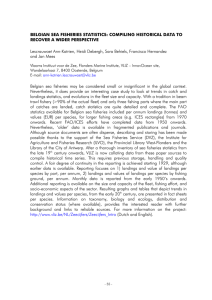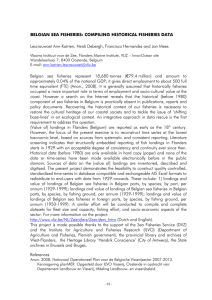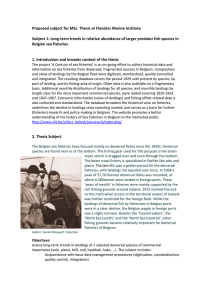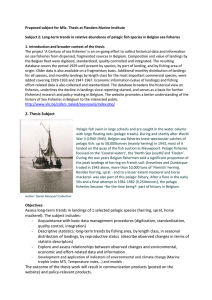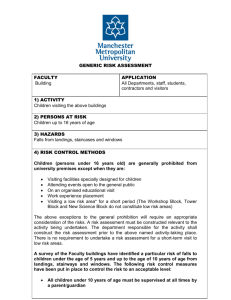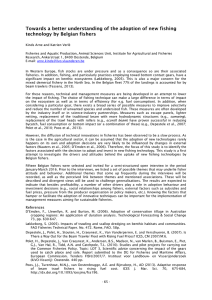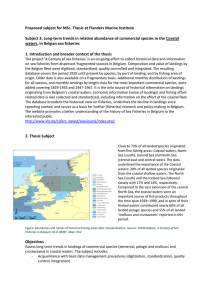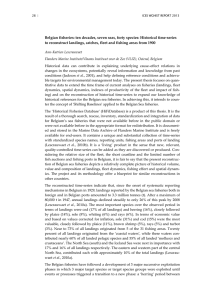CHAPTER 3. HISTORICAL DATA ON SEA FISHERIES LANDINGS IN BELGIUM
advertisement
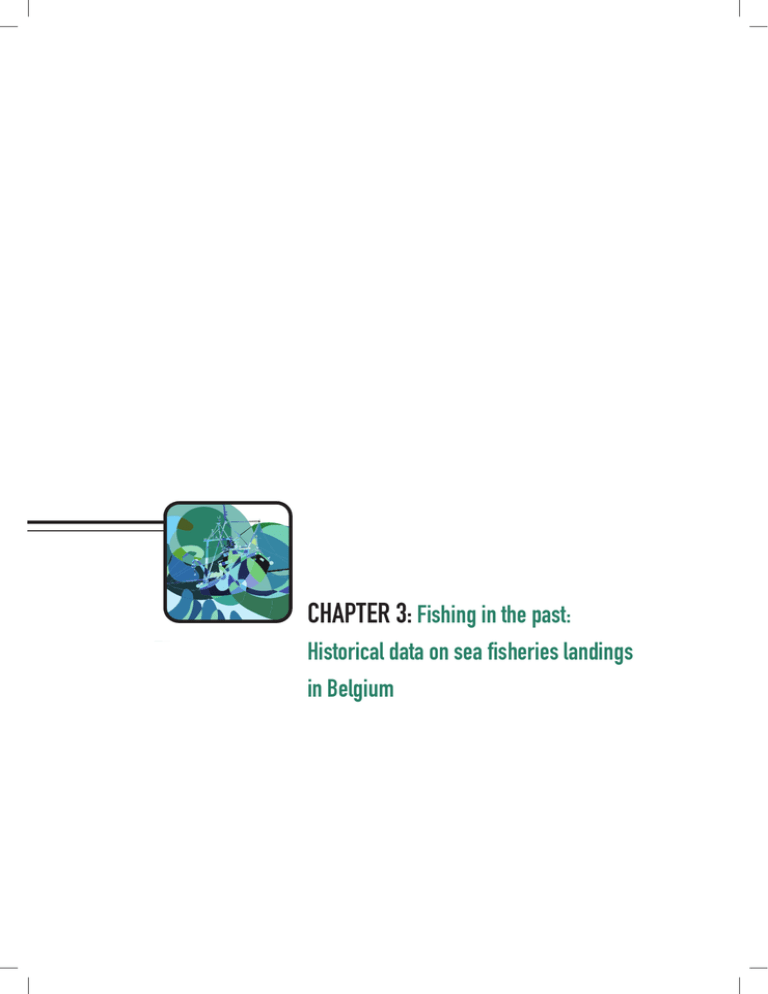
CHAPTER 3: Fishing in the past: Historical data on sea fisheries landings in Belgium Chapter 3 - Fishing in the Past Chapter 3 ‐ Fishing in the Past CHAPTER 3. HISTORICAL DATA ON SEA FISHERIES LANDINGS IN BELGIUM Published as: Lescrauwaet, A.‐K., Debergh, H., Vincx, M., Mees, J. 2010. Fishing in the past: Historical data on sea fisheries landings in Belgium. Mar. Policy 34(6): 1279‐1289, doi:10.1016/j.marpol.2010.05.006. ABSTRACT In Belgium, centralized reporting on landings of sea fisheries at the species level started in 1929. This paper summarizes the process and the results of integrating time‐series, based on fragmented and disperse data sources for the period 1929‐1999. The resulting database contains data by species (41), by port of landing in Belgium (4) and in ‘foreign ports’, and by fishing area of origin (31). After quality control, total reported landings over the period 1929‐2008 amounted to 3,320,518 tonnes (t), of which 90% was landed in Belgian ports. After a maximum of 75,370 t in 1947, annual landings declined steadily to only 26% of this peak by 2008. Currently, landings are below those achieved in 1929. The most important species in terms of landings (1929‐1999) were cod (17% of all landings) and herring (16%). In terms of economic value, sole (31%) and cod (15%) were the most valuable. Close to 73% of all landings originated from 5 of the 31 fishing areas. Twenty percent of all landings (1929‐1999) originated from the ‘coastal waters’, while these waters contributed nearly 60% of all landed pelagic species and 55% of all landed ‘molluscs and crustaceans’. Compared to the currently available ICES data, this local database offers advantages in temporal coverage (data from 1929 onwards), temporal scale (monthly values), and at the taxonomic level. It also provides more detailed information at the spatial scale of the southern and central North Sea, and it is the only source of historical information on landings originating from the coastal waters. Given the importance of the shallow and productive ‘Flemish banks’ as a local source of food in historical and recent times, this data is valuable for further research on the productivity of the coastal ecosystem and the local impact of fisheries. The database broadens the historical view on fisheries, underlines the decline in landings since reporting started, and serves as a basis for further (fisheries) research and policy‐making in Belgium. Keywords: Sea fisheries, History, Belgium, 72 75 Chapter 3 - Fishing in the Past Chapter 3 ‐ Fishing in the Past 3.1. INTRODUCTION SEA FISHERIES IN BELGIUM: A HISTORICAL PERSPECTIVE The Belgian coast is 67km long and located in the province of West‐Flanders (region of Flanders, Belgium). The Belgian part of the North Sea is 3,457km² (0.5% of the North Sea area). Belgium has 4 coastal ports (Nieuwpoort, Oostende, Zeebrugge and Blankenberge), and besides the fish auctions currently located in Oostende, Zeebrugge 1 and Nieuwpoort (Figure 3.1.) there are no other dispersed landing points today . Belgian sea fisheries represent 0.04% of the national Gross Domestic Product (Anon. 2008). In January 2009, the Belgian fisheries fleet counted 100 ships, with a total capacity of 60,620kW and 19,007 GT (Flanders Sea Fisheries Service, accessed May 2009). In 2008, the Belgian fleet landed a total of 20,012t, of which 17,307t were landed in Belgian ports. The landings represented a total value of €76.3million, 14% of which was marketed in foreign ports. Fisheries today provide direct jobs for approximately 550 fishermen (full time equivalents, FTE) and another 1,370 FTE indirectly employed in the processing sector (Platteau et al. 2008). The Belgian fleet is highly specialized: more than 95% of the total landings is achieved by beam trawlers, focusing primarily on flatfish species such as plaice (Pleuronectes platessa) and sole (Solea solea). Sole generates 48% of the current total value of fisheries in Belgium (Anon. 2008, Mees 2001). Figure 3.1.: Map of the Belgian coast with the historical fishermen‘s settlements in Flanders, the ports of Gravelines and Dunkerque in France, and the current coastal (fishing) ports of Oostende, Zeebrugge, Nieuwpoort and Blankenberge. The line indicates the boundaries of the Belgian part of the North Sea. Source: A century of Sea Fisheries in Belgium (VLIZ 2009). 1 Before WWII, an important number of vessels sailed from other coastal settlements, where (unreported) amounts of (day)fresh fish was landed (Fig.3.1. and Chapter 5: Fig. 5.2. ‐ 5.4. and 5.6.). During WWII, the ports of Dunkerque and Gravelines were mainly used to disembark the exceptional landings of herring (Chapter 7). After WWII, vessels were registered in the current 4 coastal ports. 76 73 Chapter 3 - Fishing in the Past Chapter 3 ‐ Fishing in the Past Considering the limited extent of the fleet, the short and simple coastline and the limited number of fish auctions and fishing ports, a historical reconstruction of landing statistics in Flanders/Belgium may yield a fairly complete picture of the historical situation, compared to other fishing nations. There is an increasing demand for a historical baseline of marine ecosystems, in particular fish stocks, to evaluate them and set goals for sustainable management (Pinnegar and Engelhard 2008). Recovering the historical context of our fisheries is necessary to document the cultural heritage of our coastal society and to tackle the issue of ‘shifting base‐lines’ in a marine ecology context (Pauly 1995, Pauly et al. 1998, Roberts 2007). This requires a historical perspective, at least before the onset of industrial or large‐scale intensive fishing practices, and estimations of historical biomass and fishing mortality to set baselines and evaluating the state of the marine ecosystems (Pauly 1995, Rijnsdorp et al. 1996, Roberts 2007, Cardinale et al. 2009a). However, historical time‐ series are scarce and available time‐series mostly date from after the start of intensive exploitation. Hence the baselines for rebuilding depleted fish stocks typically refer to strongly exploited situations (Pitcher 2001). Lescrauwaet et al. (2010b) searched the Internet for historical references on landings and their values, based on selected keywords, and concluded that the collective memory (cfr. publicly available data and information) in terms of Belgian sea fisheries does not surpass 30 years. The authors proposed 5 plausible reasons to explain the absence or incompleteness of data on sea fisheries before 1980: data were not collected/never existed; data exist/existed, but are not available (anymore) in the public domain; data exist and are publicly available, but data policy restrictions apply; data exist and are freely accessible, but not available in the appropriate format; data exist and are freely accessible, in appropriate format, but of insufficient reliability. To address these questions, an integrative approach was needed and a thorough data rescue based on the best available historical data and information was conducted, with the questions raised above as guidance. 3.2. OBJECTIVES The objectives of the data rescue were to identify, describe, quality control, permanently store and safeguard formal and centralized reports on historical data of Belgian sea fisheries, to integrate these data into a standardised database, and to make time‐series available to end‐users. The scope of this effort was on the production of the Belgian fleet: officially recorded landings by the Belgian fleet, in the fish auctions in Belgian ports and in foreign ports. It did not cover landings from foreign fleets in Belgian ports. Lescrauwaet et al. (2010b) give a complete overview of the methodology used for the data rescue. The present paper briefly refers to methodology, and focuses on the results and main findings in the context of the above questions. 3.3. METHODOLOGY 74 77 Chapter 3 - Fishing in the Past Chapter 3 ‐ Fishing in the Past 3.3.1. QUESTION 1: DO DATA EXIST, WERE DATA COLLECTED? Structured databases that allowed advanced querying on the basis of specific search terms were screened for publications, documents (including grey literature) and data on fisheries in Flanders/Belgium. A thorough ‐ although not exhaustive ‐ search was conducted in specialized libraries (physical and digital collections), literature databases, catalogues, internet ‘harvesters’ (e.g. JSTOR, Web of Knowledge) and historical collections (archives and documentation centres in Belgium). Most ‘promising’ inventories were screened based on titles (geographic and thematic). A complete list of historical sources consulted in the context of this review, is available from: http://www.vliz.be/cijfers_beleid/zeevisserij/pub_bijdrage.php (click on ‘Collection of publications and other sources’). Historical documents such as charters and local laws shed a light on the importance of fisheries in Flanders during the Middle Ages and the Early Modern Period. One of the early documented evidences of the extent of fish trade in Flanders can be derived from taxes levied in coastal ports for the beginning of the 11th century (Degryse 1944). Documents such as the ‘Keure van Nieuwpoort’ (city charter of Nieuwpoort) from 1163 refer to the species of fish that were caught, traded and taxed. Early published reported data on landings in Flanders refer to herring in the port of Biervliet in 1398‐1427 (Degryse and Mus 1966‐1967) and to Oostende in 1492‐1580 (Vlietinck 1975). Historical reviews and bibliography on sea fisheries in Belgium are available elsewhere (Vilain 1962, Poppe 1982, Hovart 1994), the focus of this review is on data and time‐series at the species level. 3.3.2. QUESTION 2 AND 3: ARE DATA (STILL) PUBLICLY AVAILABLE AND IF YES, WHAT DATA POLICY RESTRICTIONS APPLY? Except for the annual reports on Belgian sea fisheries which are electronic formats (pdf or html) from 1998 onwards, none of the time‐series contained in the pre‐1998 sources were available electronically in the public domain. Through the present exercise, data were digitised from the earliest year of consistent and detailed time‐ series (1929). The collection of digitised data sources and data on the composition and value of landings are now public, available on‐line, and no restriction other than the acknowledgement of sources and authors is required. 3.3.3. QUESTION 4: DATA EXIST AND ARE PUBLICLY AVAILABLE AND FREELY ACCESSIBLE, BUT ARE NOT IN THE APPROPRIATE FORMAT Data were not available before in the appropriate format for overviews or research analysis. The present data integration process included digitisation (from paper copies), quality control of the digitisation process, taxonomic and geographic standardisation, data integration and graphical analysis. The resulting integrated database on historical fisheries data (‘HiFiDatabase’) allows querying data at species level (41 species) and another 15 aggregate categories, by year (1929 until present), by fishing area (31 subareas) and by port of landing in Belgian (4 ports) and foreign ports (aggregated value), and 2 ports in France (during World War II 1940‐1945). Detailed landings of the Belgian fleet in foreign ports were covered for the period 1950 until present. Lescrauwaet et al. (2010b) describe the details of geographic standardisation. 3.3.4. QUESTION 5: DATA EXIST AND ARE FREELY ACCESSIBLE, IN APPROPRIATE FORMAT, BUT OF INSUFFICIENT RELIABILITY The problem of incompleteness and reliability of the fisheries data in Flanders/Belgium has been, as in many fishing nations, persistent over time and hard to address. In fact, early 19th and 20th century publications (e.g. Annual reports of the Province of West‐Flanders or ‘Bestuursmemoriaelen’ (Anon. 1837‐1909) and a thorough investigation on the Belgian sea fisheries by De Zuttere (1909) acknowledge the fact that state subsidies were the drive for the collection of fisheries data. Still, considering the limited extent of the fisheries (fleet and ports) and the short and 78 75 Chapter 3 - Fishing in the Past Chapter 3 ‐ Fishing in the Past simple coastline, the present historical reconstruction of landing statistics in Flanders/Belgium may depict a fairly complete picture of the historical situation as compared to other fishing nations, especially from the beginning of the 20th century onwards. A first quality control of the data sources (including graphical analysis on the integrated database) yielded an overall absolute correction of approximately 12,643t and €2.4million (nominal values, not corrected for inflation). These corrections amount to 73% of the landings of the Belgian fleet in Belgian ports in 2008. Expressed as a proportion of current value of landings (2008), this would correspond with €48.6million. The impact of this quality control may increase substantially when ‘zooming in’ on a particular species. In a second quality control, the total annual landings as reported in two different datasets were compared. The degree of consistency between both values provided a relative indication of the reliability of the data. Most of the time‐series were evaluated as excellent to good (0% to <1% difference), except for the earlier years (1933‐1935) of reporting, for the World War II period (1940‐1945), for aggregated levels of reporting units (‘miscellaneous, ‘other species’) and for some pelagic species after 1980. Finally, the data from the HiFiDatabase were compared to the values reported by ICES (Fishstat) (Section 3.4.9.). The previous assessment indicated that historical fisheries data was unavailable for science and policy‐making so far, mainly because of fragmented and poorly accessible data sources, and their (paper) format. 3.4. RESULTS AND DISCUSSION Our literature screening for time‐series on landings and the economic value of these landings indicated that structurally embedded reporting at the species level in Flanders (Belgium) started in 1929 with an acceptable consistency and continuity ever since then. The beginning of structural reporting on fisheries and landings coincided with the period where most states in Europe developed a statistic approach to underpin policy development (Julin 1918, de Reiffenberg 1932a and 1932b, François and Bracke 2000, Leti 2000). Time‐series on (value of) landings of sea fisheries in Flanders were reported at least as early as 1767 (1767‐1780; 1836‐1906) for ‘small herring fisheries’ (values), ‘large herring fisheries’ (values), ‘salted cod’ (landings) and for ‘fresh fish’ (total values for the aggregate of unidentified species). These fragmentary data are valuable when attempting to reconstruct landings per unit of effort (LPUE), socio‐economic importance, etc. in combination with other datasets. Lescrauwaet et al. (2010b) provide details on data sources. 3.4.1. TOTAL VALUE AND LANDINGS OF THE BELGIAN FISHERIES, IN BELGIAN AND FOREIGN PORTS The data integration covered the period 1929‐1999. This time‐series was extended with the data for the period 2000‐2008 currently stored at the Dienst Zeevisserij‐DVZ (Flanders Fisheries Service). The total amount of reported landings from 1929‐until present (2008) amounted to 3.3 million t, of which 3,0 million t (90%) were landed in Belgian ports and 0,3 million t in ‘foreign ports’ with an additional 20,256t in Dunkerque and Gravelines (France) during World War II. Since the peak in 1947 (75,370t), annual landings have continuously declined to represent only 26% of this ‘1947 peak’ by 2008. Since the mid 90s, total landings have not exceeded the landings achieved in 1929 (Figure 3.2.): the landings in 2008 are approximately 60% of those in 1929. 76 79 Chapter 3 - Fishing in the Past Chapter 3 ‐ Fishing in the Past 80000 70000 60000 tonnes 50000 40000 30000 20000 10000 Landed in Belgian ports (HiFiDatabase) Landed in foreign ports (HiFiDatabase) Landed in Gravelines and Dunkerque during WWII (HiFiDatabase) Landed in Belgian ports (current database DVZ) 2005 2007 2001 2003 1999 1995 1997 1991 1993 1989 1985 1987 1981 1983 1977 1979 1975 1971 1973 1969 1965 1967 1961 1963 1959 1955 1957 1951 1953 1949 1945 1947 1941 1943 1939 1935 1937 1931 1933 1929 0 Landed in foreign ports (current database DVZ) Figure 3.2: Landings of Belgian fisheries in Belgian (dark) and foreign (light) ports in the period 1929‐2008, including Dunkerque and Gravelines (France). Data for 2000‐2008 were kindly provided by the Flanders Fisheries Service. Source: ‘A century of Sea Fisheries in Belgium’ (VLIZ 2009). 140000 120000 x1000 eur 100000 80000 60000 40000 20000 2007 2005 2003 2001 1999 1995 1997 1993 1991 1989 1985 1987 1981 1983 1979 1975 1977 1973 1971 1969 1965 1967 1963 1961 1959 1955 1957 1953 1951 1949 1945 1947 1943 1941 1939 1935 1937 1933 1931 1929 0 Landed in Belgian ports (HiFiDatabase) Landed in Gravelines and Dunkerque during WWII (HiFiDatabase) Landed in foreign ports (HiFiDatabase) Landed in Belgian ports (current database DVZ) Landed in foreign ports (current database DVZ) Total value of landings (in Euro, in values 2007) Figure 3.3.: Value of landings (x €1,000) of Belgian fisheries in Belgian (dark) and foreign (light) ports between 1929‐2008. Value of landings in Gravelines and Dunkerque during World War II are inconspicuous. The line indicates the trend of value of landings corrected for inflation (values 2007). 80 77 Chapter 3 - Fishing in the Past Chapter 3 ‐ Fishing in the Past The total nominal value of these landings (1929 until 2008) amounted to €3,075 million which corrected for inflation (values 2007) represented €6,923 million (excluding World War II for which no indexes are available to correct values) (Figure 3.3.). While the peak in landings occurred in 1947, the gross income (corrected values) generated by Belgian fisheries steadily increased after 1950, peaked in 1987 and 1991 and declined afterwards. In spite of the decline in landings, the Belgian fisheries have compensated gross income thanks to the increase in market value for some species, and by focusing on selected and higher‐priced species such as common sole (S. solea). The increase in gross income however was not co‐linear to (increase in) net or real income, in particular considering the proportional importance of increasing fuel prices in the total production goods of fisheries. 3.4.2. DEMERSAL, PELAGIC AND ‘MOLLUSCS AND CRUSTACEANS’ FISHERIES: VALUE AND LANDINGS IN BELGIAN AND FOREIGN PORTS Demersal fisheries Since the 1950s, Belgian fisheries is mainly focused on demersal species, with the use of beam trawlers, and targeting flatfish such as sole and plaice. The figures for demersal fisheries showed a maximum in 1968 with landings of 57,767t, of which 4380t were landed in foreign ports (Figure 3.4.). While the landings of demersal fish by Belgian fishermen in Belgian ports steadily decreased from 1968, the landings in foreign ports slightly increased, especially during the 1990s. This peak in landings was supported by the rich fishing areas of the Iceland waters. From 1972 onwards, access to these fishing grounds became restricted when Iceland further demarcated its territorial sea from 12nm to 50nm (also known as the ‘cod wars’, see Chapter 8). From 1975 presence of Belgian fishermen within the 200nm became subject to a ‘phase‐out’. Flatfish fisheries were forced to turn towards other fishing grounds (Figure 3.5.). Besides the traditional fishing areas for Belgian fisheries (coastal waters, southern and central part of the North Sea), the ‘western waters’ (English Channel, Bristol Channel, Irish Sea,..) gained importance. 78 81 Chapter 3 - Fishing in the Past Chapter 3 ‐ Fishing in the Past 60000 50000 tonnes 40000 30000 20000 10000 Landed in Belgian ports (HiFiDatabase) Landed in foreign ports (HiFiDatabase) Landed in Belgian ports (current database DVZ) Landed in foreign ports (current database DVZ) 2007 2004 2001 1995 1998 1992 1989 1986 1983 1977 1980 1974 1971 1968 1965 1962 1959 1956 1953 1950 1947 1941 1944 1938 1935 1932 1929 0 130000 90000 80000 110000 70000 90000 70000 50000 40000 x1000eur x1000euro 60000 50000 30000 30000 20000 10000 10000 0 2007 2005 2001 2003 1999 1995 1997 1993 1991 1989 1987 1985 1981 1983 1977 1979 1975 1971 1973 1969 1965 1967 1963 1961 1959 1957 1953 1955 1951 1947 1949 1945 1941 1943 1939 1935 1937 1933 1931 1929 ‐10000 Landed in Belgian ports (HiFiDatabase) Landed in foreign ports (HiFiDatabase) Landed in Belgian ports (current database DVZ) Landed in foreign ports (current database DVZ) Total value of landings (in Euro, in values 2007) Figure 3.4: Upper panel: Landings (tonnes) of demersal fish in Belgian fisheries in Belgian ports (dark) and foreign ports (light) between 1929‐2008. lower panel: Value of landings (x1000euro) of demersal fish in Belgian fisheries in Belgian ports (dark) and foreign ports (light) between 1929‐2008. Data for 2000‐2008 were kindly provided digitally by the Flanders Fisheries Service DVZ. Source: ‘A century of Sea Fisheries in Belgium’ (VLIZ 2009). 82 79 Chapter 3 - Fishing in the Past Chapter 3 ‐ Fishing in the Past Figure 3.5.: Landings (t) of demersal fish in Belgian fisheries by fishing area of origin. Data for 2000‐2008 were kindly provided digitally by the Flanders Fisheries Service DVZ. 3.4.3. PELAGIC FISHERIES During and after World War II, unusually high landings of pelagic fish were reported with up to 58,000t (mainly herring) in 1943, of which the larger part was sold in the fish auction of Nieuwpoort. Pelagic fisheries focused on the coastal waters, the southern North Sea and Fladen (northeastern UK). During the Second World War, Belgian fishermen landed an important part of the herring catches in French (border) ports. In Gravelines and Dunkerque alone, more than 10,000t of ‘Flemish herring’ was sold in 1943 Besides herring, also sprat, mackerel and horse mackerel were targeted. Important landings of pelagic species were achieved in the early 1950s (21,402t in 1955), but after the last peak in the early 1980s (9254t in 1982) pelagic fisheries in Belgium became part of history (Figure 3.6.). 80 83 Chapter 3 - Fishing in the Past Chapter 3 ‐ Fishing in the Past 60000 50000 tonnes 40000 30000 20000 10000 Landed in foreign ports (current database DVZ) Landed in Belgian ports (current database DVZ) Landed in Gravelines and Dunkerque during WWII (HiFiDatabase) Landed in foreign ports (HiFiDatabase) 2005 2007 2001 2003 1999 1995 1997 1991 1993 1987 1989 1985 1981 1983 1979 1975 1977 1971 1973 1969 1965 1967 1961 1963 1959 1955 1957 1951 1953 1949 1945 1947 1941 1943 1939 1935 1937 1931 1933 1929 0 x1000euro Landed in Belgian ports (HiFiDatabase) 5000 20000 4500 18000 4000 16000 3500 14000 3000 12000 2500 10000 2000 8000 1500 6000 1000 4000 500 2000 Coastal waters North Sea (central‐west) South‐and West‐Ireland Total value of landings (expressed as values 2007) 84 Fladen North Sea (south) Other areas Figure 3.6: Upper panel: Landings (t) of pelagic fish in Belgian fisheries in Belgian ports (dark) and foreign ports (light) between 1929‐2008. Data for 2000‐2008 were kindly provided digitally by the Flanders Fisheries Service DVZ. Lower panel: Value (nominal) of landings (x1000euro) of pelagic fish in Belgian fisheries by fishing area between 1929‐1999. Total value expressed as values 2007 is indicated in red line. Source: ‘A century of Sea Fisheries in Belgium’ (VLIZ 2009). 81 1999 1997 1995 1991 1993 1987 1989 1983 1985 1981 1979 1977 1973 1975 1971 1969 1967 1963 1965 1961 1959 1955 1957 1951 1953 1947 1949 1943 1945 1941 1937 1939 1935 1933 1931 0 1929 0 Chapter 3 - Fishing in the Past Chapter 3 ‐ Fishing in the Past 3.4.4. MOLLUSCS AND CRUSTACEANS FISHERIES Since the early 20th century, Belgian fisheries on ‘molluscs and crustaceans’ focused on a few target species: brown shrimp (Crangon crangon), whelk (Buccinum undatum), lobsters and cephalopods. Landing statistics showed a peak value of 4343t in these seafood species in 1937 (Figure 3.7.). Although a gradual decline was visible between the mid‐1970s and the end of the 1990s, landings have increased again over the last decades. The largest proportion of molluscs and crustaceans originated from coastal waters (section 3.4.6.). 4500 4000 3500 tonnes 3000 2500 2000 1500 1000 500 Landed in Belgian ports (HiFiDatabase) Landed in foreign ports (HiFiDatabase) Landed in Belgian ports (current database DVZ) Landed in foreign ports (current database DVZ) 2005 2007 2001 2003 1999 1995 1997 1991 1993 1989 1985 1987 1981 1983 1979 1975 1977 1971 1973 1967 1969 1965 1961 1963 1959 1955 1957 1951 1953 1947 1949 1945 1941 1943 1937 1939 1935 1931 1933 1929 0 14000 12000 x1000euro 10000 8000 6000 4000 2000 Landed in Belgian ports (HiFiDatabase) Landed in foreign ports (HiFiDatabase) Landed in Belgian ports (current database DVZ) Landed in foreign ports (current database DVZ) 2005 2007 2001 2003 1999 1995 1997 1993 1991 1989 1985 1987 1983 1981 1979 1977 1975 1971 1973 1969 1967 1965 1963 1961 1959 1955 1957 1951 1953 1949 1945 1947 1941 1943 1939 1935 1937 1933 1931 1929 0 Total value of landings (in Euro, in values 2007) Figure 3.7.: upper panel: Landings (t) of ‘molluscs and crustaceans’ in Belgian fisheries in Belgian ports (dark) and foreign ports (light) between 1929‐2008. lower panel: Value of landings (x1000euro) of ‘molluscs and crustaceans’ in Belgian fisheries in Belgian ports (dark) and foreign ports (light) between 1929‐2008. Data for 2000‐2008 were kindly provided digitally by the Flanders Fisheries Service DVZ.. Source: ‘A century of Sea Fisheries in Belgium’ (VLIZ 2009). 82 85 Chapter 3 - Fishing in the Past Chapter 3 ‐ Fishing in the Past 3.4.5. MOST IMPORTANT SPECIES The level of detail available in the integrated database allowed scoring the most important species in Belgian sea fisheries in terms of landings (t) and value (€) for the period 1929‐1999, landed in Belgian and foreign ports. In terms of landings, cod and herring were the most important species. They respectively made up 17% and 16% of the total landings of Belgian fisheries (1929‐1999), closely followed by plaice (14%), sole (8%), whiting (6%) and rays (6%) (Table 3.1. and Figure 3.8.). These species made up 67% of the total amount of reported landings (3.1 million t) covered by the HiFiDatabase over the period 1929‐1999. Table 3.1: Most important species in terms of landings of Belgian sea fisheries 1929‐1999 Species Cod Herring Plaice Sole Whiting rays (aggregated class) Sum Percentage of Landings (kg) in Landings (kg) in foreign overall landings Belgian ports ports Total landings (kg) (%) 475,830,707 63,452,890 539,283,597 17 494,349,106 1,073,844 495,422,950 16 340,577,079 87,748,584 428,325,663 14 225,630,204 12,057,095 237,687,299 8 170,484,151 9,930,878 180,415,029 6 169,506,117 8,265,576 177,771,693 6 1,876,377,364 182,528,867 2,058,906,231 67 In terms of nominal value of landings, sole and plaice were the most important species. However, cumulated nominal values were negatively biased for species which generated income in the earlier years of fisheries and therefore contributed with lower nominal values. After accounting for the inflation, sole and cod appeared as the two most important species. They represented, respectively, 31% and 15% of the total (corrected) value of Belgian fisheries (1929‐1999) and were closely followed by plaice (11%), brown shrimp (5%), rays (5%) and turbot (3%). These species made up 70% of the total corrected value of reported landings (€6,075 million) covered by the HiFiDatabase over the period 1929‐1999 (Table 3.2.). 86 Table 3.2.: Most important species in terms of value of landings of Belgian sea fisheries 1929‐1999: nominal values and values corrected for inflation (reference year 2007) Nominal value of Nominal value of Total value (€) Percentage of landings (€) in landings (€) in Total nominal corrected for overall corrected Species Belgian ports foreign ports value (€) inflation value (%) 1,882,646,185 Sole 720,891,297 69,546,672 790,437,969 31 888,249,043 Cod 249,700,409 48,225,963 297,926,372 15 695,269,398 Plaice 234,873,098 107,266,892 342,139,990 11 310,118,469 Brown shrimp 79,152,943 11,069,718 90,222,661 5 279,556,322 rays (aggregated class) 70,172,223 3,207,275 73,379,498 5 208,450,538 Turbot 63,317,885 13,111,290 76,429,175 3 Sum 1,418,107,855 252,427,810 1,670,535,665 4,264,289,955 70 83 84 Figure 3.8.: Proportion of annual landings (in %) by species (or aggregation of species) from Belgian fisheries, landed in Belgian and in foreign ports (1929‐1999). Source: ‘A century of Sea Fisheries in Belgium’ (VLIZ 2009). Chapter 3 ‐ Fishing in the Past Chapter 3 - Fishing in the Past 87 Chapter 3 - Fishing in the Past Chapter 3 ‐ Fishing in the Past 3.4.6. MOST IMPORTANT FISHING AREAS Similar to the scoring of the most important species (see above), the most important fishing areas for the period 1929‐1999 were identified from the database. They were listed in order of importance in terms of landings (kg), in Table 3.3. Table 3.3.: Five most important fishing areas for the Belgian sea fisheries (1929‐1999) in terms of landed species (kg), in order of importance. Fishing area Coastal waters North sea (south) Iceland Sea North Sea (central‐west) North Sea (central‐east) Percentage (%) Total landings (kg) in Total landings (kg) in of overall Belgian ports foreign ports Total landings (kg) landings 600115224 15806841 615922065 20 515370304 17381122 532751426 17 462469753 37893907 500363660 16 220023736 77493755 297517491 10 206814279 78356942 285171221 9 Close to 73% of all landed species originated from five fishing areas: Coastal waters, North Sea (south), Iceland Sea, and North Sea (central‐east and central‐west) (Table 3.3. and Figure 3.9.). The data underlined the importance of the Coastal waters: considering the entire period 1929‐1999, 20% of all landed species originated from the coastal shallow waters. The North Sea (south) and the Iceland Sea followed closely with 17% and 16% respectively. The eastern and western part of the central North Sea, contributed each with approximately 10% of the total landings. Twenty percent of all landings originated from the central North Sea, if early reports on the spatially aggregated fishing area ‘North sea (central)’ are included. Compared to the vast extension of the central North Sea, the coastal waters were an important source of fish products throughout the time span 1929‐1999, and in spite of their limited extent contributed nearly 60% of all landed pelagic species and 55% of all landed ‘molluscs and crustaceans’ reported in this period. 3.4.7. MOST IMPORTANT FISHING PORT The landings in foreign ports were reported as one aggregated value (except for the ports of Dunkerque and Gravelines during World War II). It was therefore not possible to look at trends in landings of Belgian fisheries for individual foreign ports. Over the period covered by the HiFiDatabase, the fish auctions of Oostende and Zeebrugge were the most important. Although since 1985 Zeebrugge has taken the lead in terms of annual landings in Belgian ports, Oostende was the most important port when considering overall landings reported in Belgian ports for the entire period 1929‐1999: 68% of all landings were reported in Oostende, versus 24% in Zeebrugge, 8% in Nieuwpoort and 0.35% in Blankenberge. The decline of Oostende as main fishing port is among others related to the disappearance of the large steam‐trawlers after WWII and the gradual loss of traditional distant water fishing grounds (e.g. Icelandic waters). Also, the port Zeebrugge was of more recent construction and offered improved port facilities, to which new investments were attracted (Chapter 5). 88 85 Figure 3.9.: Proportion of annual landings (in %) from Belgian fisheries by fishing ground of origin, as landed in Belgian and in foreign ports (1929‐1999). Source: ‘A century of Sea Fisheries in Belgium’ (VLIZ 2009). 86 Chapter 3 ‐ Fishing in the Past Chapter 3 - Fishing in the Past 89 Chapter 3 - Fishing in the Past Chapter 3 ‐ Fishing in the Past 3.4.8. HISTORICAL LANDINGS TIME‐SERIES BY SPECIES BY FISHING AREA OF ORIGIN Finally, for each of the reported species, graphs were reconstructed from 1929 onwards at the species level, visualizing the annual landings (t), annual value of landings (nominal and current values in €) and annual average value (€/kg), by fishing area of origin. Figure 3.10. is an example of this reconstruction for Atlantic cod (Gadus morhua), historically the most important species in terms of landed weight. In the dataset for 2000‐2008, the fishing areas ‘North Sea (central‐east)’ and ‘North Sea (central‐west)’ were reported as one aggregated value for ‘North sea (central)’, and ‘Coastal waters’ was included as part of ‘North Sea (south)’. Current catches are compliant with the Belgian EU quota for Atlantic cod, imposed as conservation measures in the context of the depletion of fish stocks. The current landings of cod are contrasted with the well‐documented landings of ‘salted cod’ fisheries in the 19th century (1836‐1907), mainly originating from the Doggerbank and the Faroe Islands (De Zuttere 1909, after Anon. 1837‐1909) (Figure 3.10.). These total landings of salted cod from the ports of Antwerpen, Brugge, Oostende and Nieuwpoort fluctuated around 2300t before the ‘cod subsidies’ were abolished after 1867. ‘Fresh fish’ landings were reported for the same period (1836‐1907) by De Zuttere (1909), however in terms of their values (Belgian francs) and as one aggregate class. It is logical to assume that ‘fresh cod’ was part of these ‘fresh fish’ landings. However, there was no direct indication of the proportion of Atlantic cod in these ‘fresh fish’ landings, as data at the species level was not reported again until 1929 (see above). Possibly the missing part of the ‘cod history’ can be reconstructed by assembling piecemeal information from local newspapers, individual logbooks, company records. 24000 Data for salted cod only 22000 20000 18000 tonnes 16000 14000 12000 10000 8000 6000 4000 2000 Coastal waters North Sea (central‐east) North Sea (central‐west) North Sea (central)* North Sea (south) Other salted cod* (Doggerbank and Faroer) 2001 2006 1991 Iceland Sea 1996 1981 1986 1971 1976 1966 1961 1951 1956 1941 1946 1936 1931 1921 1926 1911 1916 1901 1906 1891 1896 1886 1881 1871 1876 1861 1866 1856 1851 1841 1846 1836 0 Figure 3.10: Landings (t) of Atlantic cod in Belgian fisheries in Belgian and foreign ports, by fishing area between 1836‐1907 (salted cod) and 1929‐2008. No data between 1908 and 1929. Data from 2000 onwards were kindly provided digitally by the Flanders Fisheries Service DVZ. See text for notes on ‘salted cod*’ and ‘North Sea (central)*. Source: ‘A century of Sea Fisheries in Belgium’ (VLIZ 2009). 90 87 Chapter 3 - Fishing in the Past Chapter 3 ‐ Fishing in the Past 3.4.9. COMPARISON OF THE HIFIDATABASE TO ICES LANDING STATISTICS A comparison between the ICES database and the local database was conducted to look for possible inconsistencies. ICES data were obtained from Fishstat (ICES 2008). For Belgian sea fisheries, Fishstat contained aggregated landings from the ’Northeast Atlantic’ area (Statlant27), landed both in Belgian ports and in foreign ports from 1950 onwards, expressed as ‘fresh weight equivalents’. These ‘fresh weight’ values were reported by countries after conversion of ‘dead weight’ as recorded in the auction, with species‐specific conversion factors. The HiFiDatabase contained the original non‐converted data (dead weight) as recorded in the auctions. Therefore, the sum of the components (ICES data by species) was not necessarily co‐linear to the landings in the HiFiDatabase. Moreover, not all species were subject to reporting since the beginning of ICES reporting, or the reported aggregations of species did not allow a ‘species to species’ comparison between the two databases. As expected, the annual values for total landings from HiFiData were consistently lower than ICES data over the entire period due to the difference between dead and fresh weight. Subtotals (dead weight) by individual species were converted to fresh weight equivalents by multiplying with the corresponding species‐specific conversion factor, where applicable. The over‐ or underreporting was not systematical between years nor was it associated with the first decades of reporting. Therefore it could not be explained by changes in the conversion rates compared to earlier reporting years. For some species (Atlantic horse mackerel, Atlantic wolffish, common shrimp, European sea bass, European hake, surmullet, pouting, etc.), the HiFiDatabase reported overall higher landings than the ICES data after conversion to fresh weight. For others (Atlantic herring, European plaice, European sole, Atlantic cod, European flounder, European conger, etc.) the Fishstat total reports were higher. Our calculations indicated that, for the demersal species which were reported both by HiFiData ánd by ICES, the sum of the HiFiData landings by species converted to live weight was still approximately 288,000t lower than that reported in ICES. More details on the outcome of this comparison are available in Chapter 2. 150 Fishstat > HiFiData 100 50 ‐150 Edible crab Saithe(=Pollock) total gurnards and searobins European flounder Atlantic redfishes 'other' European hake European conger Whelk Whiting Turbot All sharks reported in ICES Surmullet bib Raja rays nei Pollack All lobsters reported in ICES Monkfishes nei Ling Megrim Haddock Lemon sole European sprat European seabass Common sole European plaice TOTAL cuttlefish‐octopus and squids HiFiData > Fishstat Common shrimp Brill Common dab Atlantic wolffish Atlantic mackerel Atlantic herring Atlantic horse mackerel ‐100 Atlantic cod ‐50 Atlantic halibut 0 Figure 3.11: Discrepancy (%) between reported landings (t) in HiFiData and Fishstat, by species or aggregated groups of species (1950‐1999). Positive values indicate higher reported landings in Fishstat, while negative values mean that the national HiFiDatabase (after conversion for fresh weight) reported higher landings (VLIZ 2009). 88 91 Chapter 3 - Fishing in the Past Chapter 3 ‐ Fishing in the Past 3.5. CONCLUSION The efforts of data integration extended digitally available and detailed time‐series on landings (by species, by fishing area, by port, per annum) with approximately 60 years. To our knowledge, and as far as the screening of literature, sources and archives have indicated, it was the first attempt in Belgium to collect, archive and integrate the available historical sea fisheries statistics. The added value for science and policy is summarized as: 3.5.1. DIGITISED INVENTORY AND ANNOTATED BIBLIOGRAPHY The results of literature screening and inventory are digitally available and can be queried (by author, by keyword(s), by year of publication, other) in the online catalogue through the modular Integrated Marine Information System IMIS managed by Flanders Marine Institute VLIZ (VLIZ). 3.5.2. INTEGRATED DATABASE Data, graphs, maps and other products are accessible for end‐users. In spite of the limitations inherent to the HiFiDatabase ‐ many of which also apply to current data ‐ it offers interesting advantages compared to the current ICES database: the temporal coverage (from 1929 onwards), the temporal scale (data on monthly landings and length classes available between 1941 and 1967) and the taxonomic level (few aggregated groups in reporting). The database contains data on the evolution of value (€) and average price (€/kg) at the species level, since 1929. The data rescue process and metadata (standards, methods, quality control) were described in an on‐line ‘Users Guidelines’ and the integrated database made available for further research purposes. Reliability maps provide users with an indication of the relative reliability of the data. In the absence of catch statistics, integrated and quality controlled landing statistics can be used in a number of applications and models as a proxy for fishing mortality (Daan et al. 1994, Walker and Heessen 1996, Zeller and Pauly 2007, Eero et al. 2008) and for further analysis related to the setting of historical baselines. 3.5.3. ACCESSIBLE RESULTS IN AN APPROPRIATE FORMAT FOR POLICY LEVEL, SCIENCE AND THE INTERESTED PUBLIC Data integration showed that total annual landings have continuously declined since 1947 to reach only 26% by 2008.The annual landings in 2008 were approximately 60% of those achieved in 1929. Being the only source of information on origin of landings, the database quantified the coastal waters as the most important fishing area for the Belgian sea fisheries (1929‐1999). Given the importance of the shallow and productive coastal ‘Flemish banks’ as a source of food for Flanders in historical and recent times, this data is valuable for a qualitative and quantitative study of the historical and cumulative productivity of the ecosystem and the ecological impact of fisheries. The HiFiDatabase can serve as a basis for further research and analysis of fish stocks and provide background information for research on fisheries ecosystems. ACKNOWLEDGEMENTS The support of a many persons who contributed to this project by digitizing data, drawing maps, developing web applications is acknowledged on the Internet webpages of this project. P. Rogiest (Heritage Library Hendrik Conscience Antwerpen, Belgium), M. Vandermaesen, F. Strubbe and L. Vandeweyer (State Archives Belgium), provided expert assistance with the Archives. Prof. F. Volckaert (Catholic University of Leuven, Belgium), H.Polet (Institute of Agriculture and Fisheries Research‐ILVO, Flanders), E. Tessens and M. Velghe (Sea Fisheries department, Flanders), W. Versluys (company owner), provided valuable references and expert advice. 92 89
